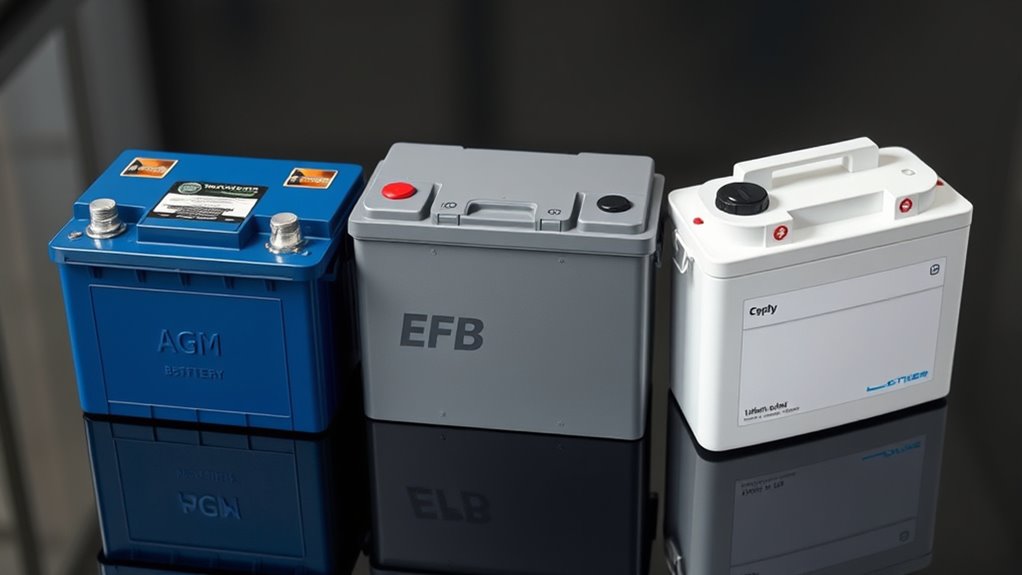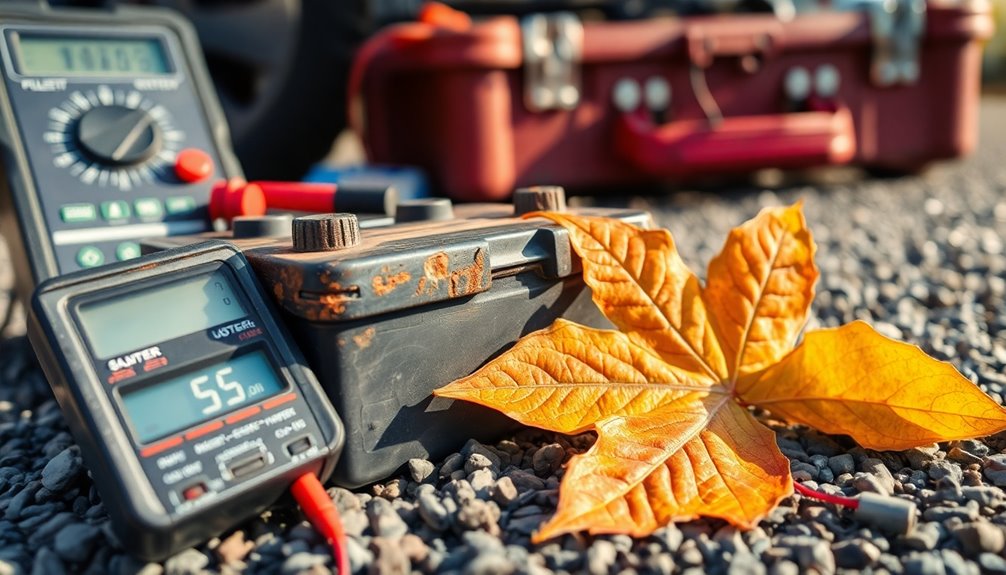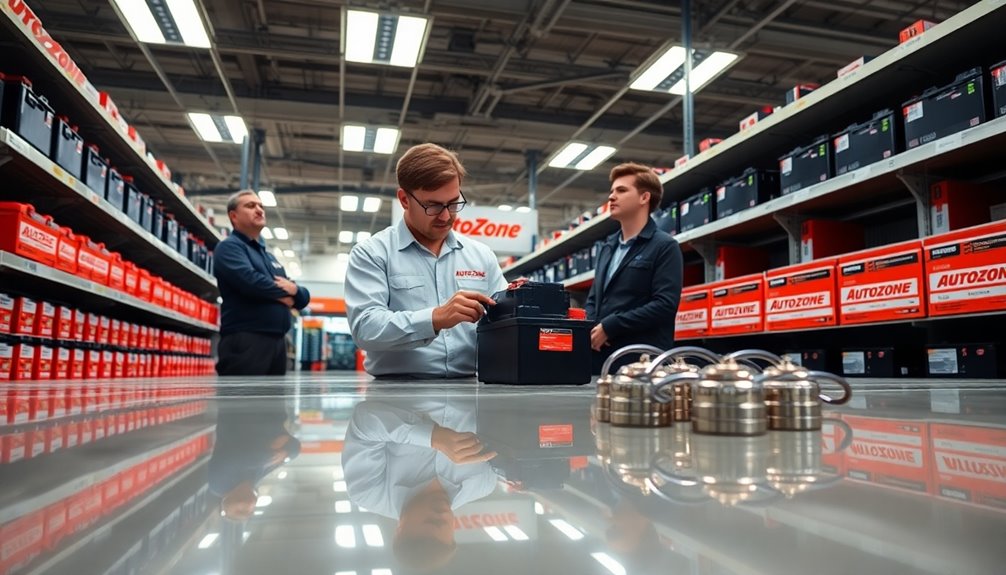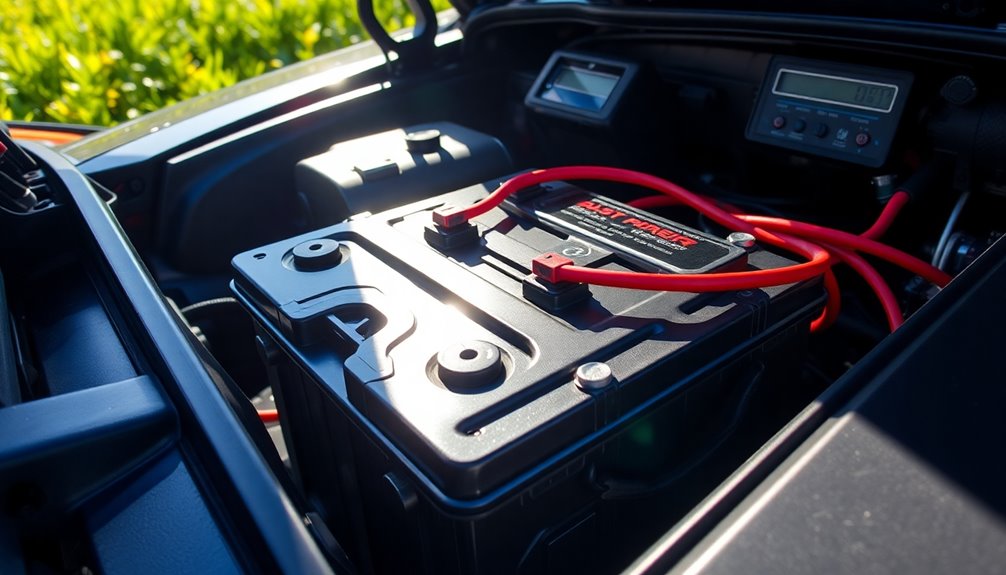If you’re choosing between AGM, EFB, and lithium car batteries, consider performance, lifespan, and cost. AGM batteries deliver high durability and support modern vehicle systems but tend to be more expensive upfront. EFB options are budget-friendly with moderate longevity, suitable for everyday use. Lithium batteries last the longest and offer rapid charging, but they come with a higher initial price. To find the best fit for your needs and budget, keep exploring the details below.
Key Takeaways
- AGM batteries offer high durability and performance but at a higher initial cost than EFB batteries.
- EFB batteries provide a cost-effective balance with moderate lifespan and better deep-discharge handling than standard flooded batteries.
- Lithium batteries deliver longer lifespan, rapid charging, and high energy density, suitable for electric and hybrid vehicles.
- AGM and EFB contain lead and acid, requiring specialized recycling, whereas lithium batteries need advanced facilities for recycling lithium and metals.
- Choice depends on budget, vehicle electrical demands, performance needs, and environmental considerations.
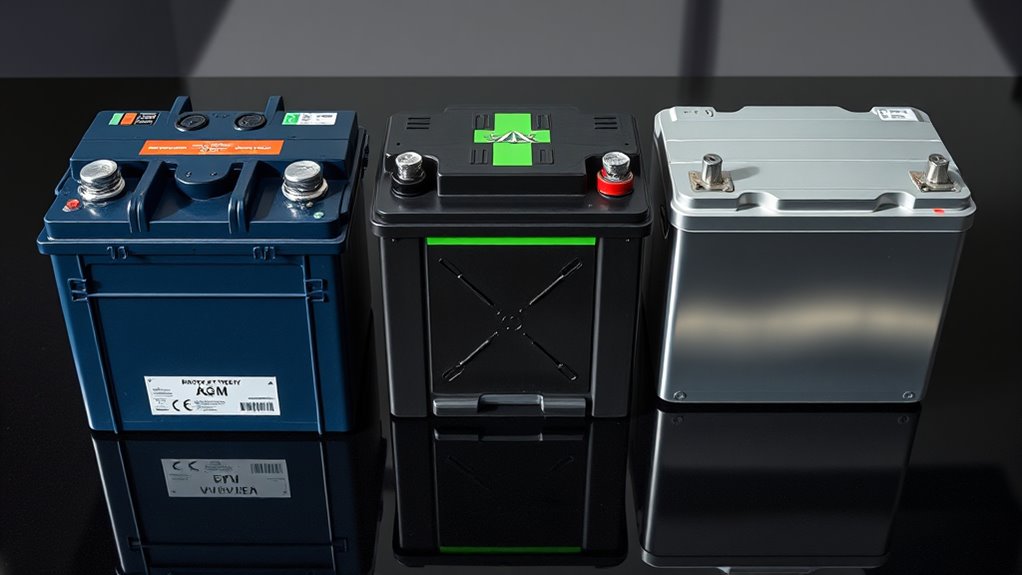
When choosing a car battery, understanding the differences between AGM, EFB, and Lithium options is essential to make an informed decision. Each type offers distinct advantages and drawbacks, especially when it comes to battery lifespan and recycling challenges. Your choice can impact not only your vehicle’s performance but also your long-term costs and environmental footprint.
AGM (Absorbed Glass Mat) batteries are known for their durability and high performance. They typically have a longer battery lifespan compared to EFB (Enhanced Flooded Battery) models, often lasting 4 to 7 years with proper care. This longevity makes them a popular choice for modern vehicles with advanced electrical systems. However, their advanced technology and materials come with a higher initial cost. Recycling AGM batteries can be complex because they contain lead and acid, which require specialized facilities to handle safely. If not properly recycled, these materials can pose environmental risks, making responsible disposal vital. Additionally, AGM batteries are often used in Honda Tuning vehicles to support high-performance modifications like turbochargers or upgraded electronics.
EFB batteries, meanwhile, are a step up from traditional flooded batteries but generally don’t last as long as AGM types. You can expect an EFB battery to serve you well for about 3 to 5 years. They’re more affordable upfront and easier to recycle because they also contain lead and acid, similar to AGM batteries. Still, recycling challenges remain, especially in regions lacking proper facilities. These batteries are designed to handle frequent deep discharges better than standard flooded batteries, making them suitable for vehicles with moderate electrical demands. If you’re budget-conscious but still want decent performance and easier recycling, EFB batteries could be a practical choice.
Lithium batteries are gaining popularity due to their lightweight design, rapid charging, and impressive performance. They often last longer than both AGM and EFB options, with some models reaching 8 to 10 years. Their high energy density makes them ideal for electric and hybrid vehicles. However, their higher cost can be a barrier for many users. Recycling Lithium batteries presents its own challenges—while they don’t contain lead or acid, they require specialized facilities to recover valuable materials like lithium, cobalt, and nickel. Improper disposal can lead to environmental hazards, but advancements in recycling technology are gradually making these processes more efficient and sustainable.
Frequently Asked Questions
Which Battery Type Has the Longest Lifespan Under Extreme Weather?
You’ll find that lithium batteries have the longest lifespan under extreme weather conditions. Their superior thermal resilience helps them withstand high temperatures and cold snaps without degrading quickly, ensuring better battery durability. Unlike AGM and EFB batteries, which can suffer from thermal stress, lithium batteries maintain performance longer in harsh environments. So, if you need a reliable power source in extreme weather, lithium batteries are your best choice for longevity and resilience.
How Do Maintenance Requirements Differ Among AGM, EFB, and Lithium Batteries?
Think of battery upkeep as tending a garden—you need to give each type the right care. AGM batteries require minimal maintenance, so you check the terminals and keep spill prevention measures in place once or twice a year. EFB batteries need slightly more frequent checks, especially for fluid levels. Lithium batteries demand the least effort, mainly avoiding overcharging. Overall, maintenance frequency varies, but spill prevention is vital for all to guarantee safety and longevity.
Are There Environmental Concerns Associated With Each Battery Type?
You should know that each battery type has environmental concerns. AGM and EFB batteries contain lead, posing recycling challenges and risks of lead exposure if not properly handled. Lithium batteries require resource extraction, which can harm ecosystems and involve hazardous mining practices. While lithium batteries are more energy-efficient, they still present recycling challenges. Proper disposal and recycling are essential to minimize environmental impacts for all these battery types.
How Do Charging Times Vary Between AGM, EFB, and Lithium Batteries?
Think of your battery as a race car—charging times can make or break your performance. Lithium batteries charge faster, thanks to superior charging efficiency, so you spend less time plugged in. AGM and EFB batteries take longer due to lower charging efficiency, and their compatibility with your vehicle’s charging system matters. Overall, lithium offers quicker charging, while AGM and EFB may require more patience for a full charge.
What Are the Warranty Differences for Each Battery Type?
You’ll find that warranty policies vary considerably among AGM, EFB, and lithium batteries. AGM batteries often come with longer warranties, reflecting their greater battery longevity and durability. EFB warranties are usually shorter, but still offer decent coverage. Lithium batteries typically include warranties of 8-10 years, emphasizing their superior lifespan. Always check specific manufacturer policies, as warranty coverage can differ based on usage and maintenance, ensuring you get the best protection for your investment.
Conclusion
Choosing between AGM, EFB, and lithium car batteries is like picking the right instrument for your car’s symphony. AGM batteries deliver steady rhythm, EFBs add a bit more punch, while lithiums lead with a lightning-fast beat. Consider your budget, performance needs, and longevity. When you strike the perfect balance, your car runs smoothly, like a well-conducted orchestra, hitting all the right notes without missing a beat. Your ideal battery awaits to power your journey ahead.

